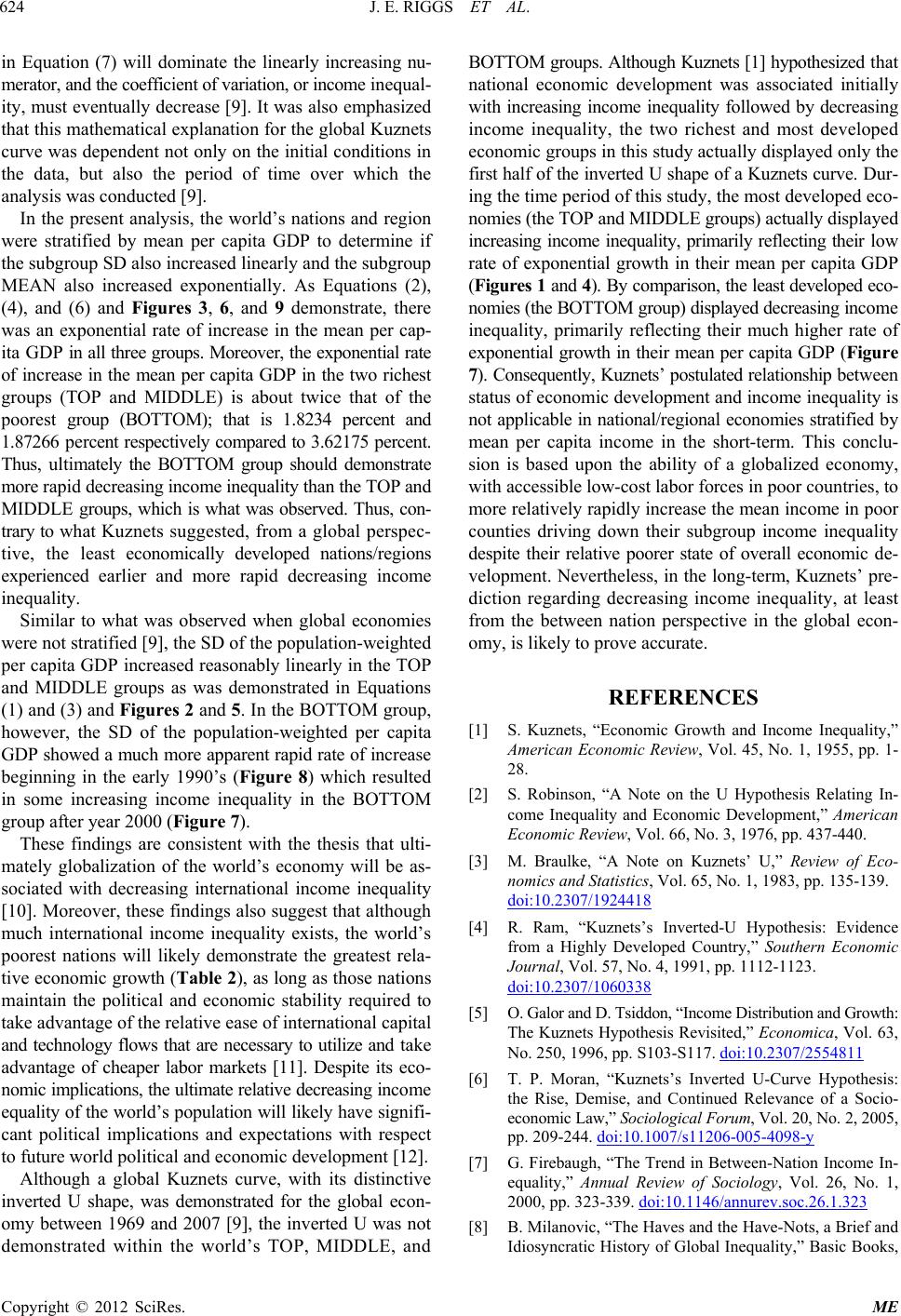
J. E. RIGGS ET AL.
624
in Equation (7) will dominate the linearly increasing nu-
merator, and the coefficient of variation, or income inequal-
ity, must eventually decrease [9]. It was also emphasized
that this mathematical explanation for the global Kuznets
curve was dependent not only on the initial conditions in
the data, but also the period of time over which the
analysis was conducted [9].
In the present analysis, the world’s nations and region
were stratified by mean per capita GDP to determine if
the subgroup SD also in cr eased lin ear ly and th e subgr oup
MEAN also increased exponentially. As Equations (2),
(4), and (6) and Figures 3, 6, and 9 demonstrate, there
was an exponential rate of increase in the mean per cap-
it a GD P in all three groups. Moreover, the exponential rate
of incr ease in the mean per capita GDP in the two richest
groups (TOP and MIDDLE) is about twice that of the
poorest group (BOTTOM); that is 1.8234 percent and
1.87266 pe rcent respectively compared to 3.62175 percent.
Thus, ultimately the BOTTOM group should demonstrate
more rapid decreasing income inequality than the TOP and
MIDDL E groups, which is what was observed. Thus, con-
trary to what Kuznets suggested, from a global perspec-
tive, the least economically developed nations/regions
experienced earlier and more rapid decreasing income
inequality.
Similar to what was observed when global economies
were not stratified [9], the SD of the population-weighted
per capita GDP increased reasonably linearly in the TOP
and MIDDLE groups as was demonstrated in Equations
(1) and (3) and Figures 2 and 5. In the BOTTOM group,
however, the SD of the population-weighted per capita
GDP showed a much more apparent rapid rate of increa se
beginning in the early 1990’s (Figure 8) which resulted
in some increasing income inequality in the BOTTOM
group after year 2000 (Figure 7).
These findings are consistent with the thesis that ulti-
mately globalization of the world’s economy will be as-
sociated with decreasing international income inequality
[10]. Moreover, th ese findings also suggest that although
much international income inequality exists, the world’s
poorest nations will likely demonstrate the greatest rela-
tive economic growth (Table 2), as long as those nations
maintain the political and economic stability required to
take advantage of the relative ease of international capital
and technology flows that are necessary to utilize and take
advantage of cheaper labor markets [11]. Despite its eco-
nomic implications, the ultimate relative decreasing inco me
equality of the world’s population will likely have signif i-
cant political implications and expectations with respect
to future world political and economic development [12].
Although a global Kuznets curve, with its distinctive
inverted U shape, was demonstrated for the global econ-
omy between 1969 and 2007 [9], the inverted U was not
demonstrated within the world’s TOP, MIDDLE, and
BOTTOM groups. Although Kuznets [1] hypo thesized t h at
national economic development was associated initially
with increasing income inequality followed by decreasing
income inequality, the two richest and most developed
economic groups in this study actually displayed only the
first half of the inverted U shape of a Kuznets curve. Dur -
ing the time period of this study, the most developed eco-
nomies (the TOP and MIDDLE groups) actually displayed
increasing income inequality, primarily reflecting their low
rate of exponential growth in their mean per capita GDP
(Figures 1 and 4). By comparison, the least developed eco-
nomies (the BOTTOM group) displayed decreasing in co me
inequality, primarily reflecting their much higher rate of
exponential growth in their mean per capita GDP (Figure
7). Consequently, Kuznets’ postulated relationship betw ee n
status of economic development and income inequality is
not applicable in national/regional economies stratified by
mean per capita income in the short-term. This conclu-
sion is based upon the ability of a globalized economy,
with accessible low-cost labor forces in poor countries, to
more relatively rapidly increase the mean income in poor
counties driving down their subgroup income inequality
despite their relative poorer state of overall economic de-
velopment. Nevertheless, in the long-term, Kuznets’ pre-
diction regarding decreasing income inequality, at least
from the between nation perspective in the global econ-
omy, is likely to prove accurate.
REFERENCES
[1] S. Kuznets, “Economic Growth and Income Inequality,”
American Economic Review, Vol. 45, No. 1, 1955, pp. 1-
28.
[2] S. Robinson, “A Note on the U Hypothesis Relating In-
come Inequality and Economic Development,” American
Economic Review, Vol. 66, No. 3, 1976, pp. 437-440.
[3] M. Braulke, “A Note on Kuznets’ U,” Review of Eco-
nomics and Statistics, Vol. 65, No. 1, 1983, pp. 135-139.
doi:10.2307/1924418
[4] R. Ram, “Kuznets’s Inverted-U Hypothesis: Evidence
from a Highly Developed Country,” Southern Economic
Journal, Vol. 57, No. 4, 1991, pp. 1112-1123.
doi:10.2307/1060338
[5] O. Galor and D. Tsiddon, “Income Distribution and Growth:
The Kuznets Hypothesis Revisited,” Economica, Vol. 63,
No. 250, 1996, pp. S103-S117. doi:10.2307/2554811
[6] T. P. Moran, “Kuznets’s Inverted U-Curve Hypothesis:
the Rise, Demise, and Continued Relevance of a Socio-
economic Law,” Sociological Forum, Vol. 20, No. 2, 2005,
pp. 209-244. doi:10.1007/s11206-005-4098-y
[7] G. Firebaugh, “The Trend in Between-Nation Income In-
equality,” Annual Review of Sociology, Vol. 26, No. 1,
2000, pp. 323-339. doi:10.1146/annurev.soc.26.1.323
[8] B. Milanovic, “The Haves and the Have-Nots, a Brief and
Idiosyncratic History of Global Inequality,” Basic Books,
Copyright © 2012 SciRes. ME